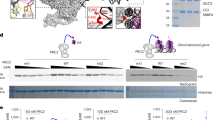Abstract
Meiosis generates haploid gametes from diploid cells and is an almost universal feature of eukaryotic organisms. But little is known about how the switch from mitotic to meiotic cell cycles is molecularly controlled. In the fission yeast Schizosaccharomyces pombe, inactivation of the protein kinase Pat1(Ran1) upon nutrient deprivation triggers entry into the meiotic cell cycle1–6. Here we show that the RNA-binding protein Mei2 is a substrate of Pat1 kinase and that dephosphorylation of Mei2 is sufficient to switch cells from the mitotic cell cycle into meiosis. Mei2 is localized mainly in the cytoplasm of proliferating cells but is seen as a single spot close to the microtubule organizing centre in prophase nuclei during meiosis. Our results, and others from a metazoan7, emphasize the crucial role of RNA-binding proteins in the initiation and execution of meiosis.
This is a preview of subscription content, access via your institution
Access options
Subscribe to this journal
Receive 51 print issues and online access
$199.00 per year
only $3.90 per issue
Buy this article
- Purchase on Springer Link
- Instant access to full article PDF
Prices may be subject to local taxes which are calculated during checkout
Similar content being viewed by others
References
lino, Y. & Yamamoto, M. Mol. Gen. Genet. 198, 416–421 (1985).
Nurse, P. Mol. Gen. Genet. 198, 497–502 (1985).
Beach, D., Rodgers, L. & Gould, J. Curr. Genet. 10, 297–311 (1985).
McLeod, M., Stein, M. & Beach, D. EMBO J. 6, 729–736 (1987).
McLeod, M. & Beach, D. Nature 332, 509–514 (1988).
Yamamoto, M. Trends Biochem. Sci. 21, 18–22 (1996).
Eberhart, C. G., Maines, J. Z. & Wasserman, S. A. Nature 381, 783–785 (1996).
Egel, R. in Molecular Biology of the Fission Yeast (eds Nasim, A. et al.) 31–73 (Academic, San Diego, 1989).
lino, Y. & Yamamoto, M. Proc. Natl Acad. Sci. USA 82, 2447–2451 (1985).
Watanabe, Y., lino, Y., Furuhata, K., Shimoda, C. & Yamamoto, M. EMBO J. 7, 761–767 (1988).
Birney, E., Kumar, S. & Krainer, A. R. Nucleic Acids Res. 12, 5803–5816 (1993).
Watanabe, Y. & Yamamoto, M. Cell 78, 487–498 (1994).
Robinow, S., Campos, A., Yao, K. & White, K. Science 242, 1570–1572 (1988).
Nakashima, N., Tanaka, K., Sturm, S. & Okayama, H. EMBO J. 14, 4794–4802 (1995).
Fernandez-Sarabia, M. J., Mcinerny, C., Harris, P., Gordon, C. & Fantes, P. Mol. Gen. Genet. 238, 241–251 (1993).
Sugiyama, A., Tanaka, K., Okazaki, K., Nojima, H. & Okayama, H. EMBO J. 13, 1881–1887 (1994).
Chalfie, M., Tu, Y., Euskirchen, G., Ward, W. W. & Prasher, D. C. Science 263, 802–805 (1994).
Chikashige, Y. et al. Science 264, 270–273 (1994).
Bohmann, K., Fereira, J., Santama, N., Weis, K. & Lamond, A. I. J. Cell Sci. (suppl.) 19, 107–113 (1995).
Li, P. & McLeod, M. Cell 87, 869–880 (1996).
Sugimoto, A., Iino, Y., Maeda, T., Watanabe, Y. & Yamamoto, M. Genes Dev. 5, 1990–1999 (1991).
Basi, G., Schmidt, E. & Maundrell, K. Gene 123, 131–136 (1993).
Mochizuki, N. & Yamamoto, M. Mol. Gen. Genet. 233, 17–24 (1992).
McLeod, M. & Beach, D. EMBO J. 5, 3665–3671 (1986).
Boyle, W. J., Geer, P. V. d. & Hunter, T. Meth. Enzymol. 201, 110–149 (1991).
Heim, R., Cubitt, A. B. & Tsien, R. Y. Nature 373, 663–664 (1995).
Hiraoka, Y., Swedlow, J. R., Paddy, M. R., Agard, D. A. & Sedat, J. W. Semin. Cell Biol. 2, 153–165 (1991).
Shimoda, C. et al. J. Bacterial. 169, 93–96 (1987).
Takeda, T. & Yamamoto, M. Proc. Natl Acad. Sci. USA 84, 3580–3584 (1987).
Author information
Authors and Affiliations
Rights and permissions
About this article
Cite this article
Watanabe, Y., Shinozaki-Yabana, S., Chikashige, Y. et al. Phosphorylation of RNA-binding protein controls cell cycle switch from mitotic to meiotic in fission yeast. Nature 386, 187–190 (1997). https://doi.org/10.1038/386187a0
Received:
Accepted:
Issue Date:
DOI: https://doi.org/10.1038/386187a0
This article is cited by
-
A scaffold lncRNA shapes the mitosis to meiosis switch
Nature Communications (2021)
-
Computational modelling of meiotic entry and commitment
Scientific Reports (2018)
-
Gamete fusion triggers bipartite transcription factor assembly to block re-fertilization
Nature (2018)
-
Sexual development of Schizosaccharomyces pombe is induced by zinc or iron limitation through Ecl1 family genes
Molecular Genetics and Genomics (2015)
-
Synchronized fission yeast meiosis using an ATP analog–sensitive Pat1 protein kinase
Nature Protocols (2014)
Comments
By submitting a comment you agree to abide by our Terms and Community Guidelines. If you find something abusive or that does not comply with our terms or guidelines please flag it as inappropriate.



